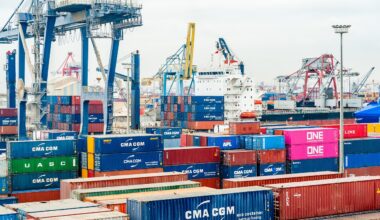Using Import and Export Price Data to Forecast Economic Growth
To navigate the complex landscape of global trade, businesses and policymakers rely heavily on data. Among the various metrics, import and export prices stand out as crucial economic indicators. These prices reflect the demand and supply dynamics in international markets and offer insights into inflationary trends. By analyzing changes in import and export prices, one can gauge the competitiveness of domestic industries relative to foreign markets. Moreover, this data sheds light on the cost of goods to consumers and the potential profit margins for producers. When these indices trend upwards or downwards, they signal shifting economic conditions that may influence decisions regarding investment and production. Import and export prices serve as vital signs of economic health, revealing the overall demand for a nation’s goods abroad. This information can forecast economic growth trends, helping stakeholders anticipate future developments. Therefore, understanding how to interpret these price movements is essential for making informed economic predictions. Policymakers and businesses alike can harness this data to enhance their strategies. Accurate forecasting is vital for long-term planning and creating stability in an often-volatile market.
International trade dynamics are constantly evolving, which is evident through the fluctuations in import and export prices. Tracking these movements provides businesses with an invaluable tool for forecasting economic growth. To leverage this data effectively, organizations employ statistical models that analyze historical trends and current market conditions. This interplay of information helps predict future price changes, offering businesses a strategic advantage. Additionally, import and export prices impact currency valuations, influencing exchange rates. A stronger currency can affect export prices, potentially leading to decreased competitiveness abroad. Conversely, lower import prices can ease domestic inflationary pressures, giving consumers more purchasing power. The correlation between these price indices and economic indicators like GDP growth further underscores their importance. Economists rigorously study this relationship to draw conclusions about economic performance. For businesses, this means staying agile and responsive to price indicators, allowing them to adjust their operations accordingly. Furthermore, the interplay of domestic policies and global market dynamics creates an intricate web that necessitates continuous monitoring. Armed with insights gained from import and export price analyses, stakeholders can make better-informed decisions in a rapidly changing economy.
Significance of Import and Export Prices
Beyond immediate financial implications, import and export prices play a pivotal role in shaping economic policy. Countries experiencing significant shifts in trade prices often adjust tariffs or quotas to protect domestic industries. For analysts, distinguishing between temporary fluctuations and long-term trends in these indices is essential. Such discernment enables the crafting of proactive economic policies. When businesses observe rising export prices, they may anticipate increased production to capitalize on favorable conditions. In contrast, sudden drops in import prices can trigger responses such as increased imports to meet consumer demands. The adaptive nature of these markets necessitates that all stakeholders understand the underlying factors influencing prices. Market sentiment, geopolitical events, and domestic economic policies are just a few of the elements affecting import and export prices. A comprehensive understanding empowers businesses and policymakers to navigate these changes effectively. Additionally, insights derived from price data facilitate cross-border negotiations, enhancing a country’s bargaining position in trade agreements. Hence, the significance of import and export prices extends beyond mere statistics; they are fundamental aspects of economic strategy and global relations, guiding the trajectory of national and global economies.
The interplay between import and export prices can significantly influence economic growth at a national level. When export prices rise, it typically indicates that a country is producing goods that are in high demand overseas, leading to increased revenues and improved trade balances. This, in turn, can foster job creation and investment in domestic industries. Conversely, if import prices decline, consumers enjoy lower costs, thus enhancing their purchasing power. Such dynamics often lead to increased consumer spending, propelling economic growth further. Research has demonstrated that countries that effectively manage their trade balances through these price indices experience more robust economic performance. Economists closely monitor these changes, understanding that they can provide critical insights into future economic conditions. Moreover, businesses can adapt their strategies in response to anticipated shifts, ensuring resilience in challenging markets. As nations continue to integrate further into the global economy, the ability to decode import and export price movements becomes paramount. The capacity to forecast potential economic downturns or booms based on these indicators reinforces the importance of data-driven decision-making. Consequently, these price metrics are indispensable tools for forecasting economic growth and ensuring financial stability.
Implications for Policymakers
For policymakers, understanding import and export price trends is critical in formulating economic strategies. Accurate data analysis allows for timely interventions that can mitigate adverse effects stemming from volatile markets. For instance, if rising import prices indicate inflationary pressures, policymakers might consider adjusting monetary policy to stabilize prices. Alternatively, a decline in export prices could prompt government incentives to enhance competitiveness in the export market. Moreover, the implications of these price fluctuations extend beyond mere statistics; they influence public sentiment and trust in economic governance. Engaged citizens demand transparency and informed leadership in navigating these economic indicators. This necessitates that policymakers translate complex data into actionable strategies that resonate with the populace. Additionally, global events such as trade agreements or tariffs also significantly affect import and export prices, requiring agile policy frameworks to adapt to these changes. The interplay between domestic policies and international trade dynamics creates a complex regulatory environment. Policymakers must remain vigilant to ensure that economic strategies align with both immediate needs and long-term goals. Thus, leveraging import and export price data effectively fosters a more resilient economy capable of weathering global uncertainties.
Access to accurate import and export price data can empower businesses and policymakers alike to make informed decisions. Companies that actively track these trends often gain insights that enhance strategic planning and market positioning. To maintain competitiveness, firms must remain proactive in understanding how global events—ranging from trade agreements to geopolitical tensions—affect pricing structures. Furthermore, businesses can utilize analytics to anticipate shifts in consumer demand based on these price movements. For instance, if increased agricultural import prices result from adverse weather conditions, domestic producers may ramp up their output to meet local needs. Consequently, adaptive strategies become vital for maximizing profitability and sustaining growth. Import and export price data also reveal emerging market trends, offering opportunities for expansion or diversification. Organizations can explore potential partnerships and explore new markets based on the intelligence derived from these indices. Hence, the business landscape is increasingly dependent on accurate data to drive decisions, create value, and sustain competitive advantage. Fostering a culture of data-driven decision-making not only enhances economic forecasts, but also leads to a more robust approach to navigating uncertainties in global trade.
The Future of Price Data Analysis
The future of economic forecasting will undeniably hinge on advancements in data analysis techniques surrounding import and export prices. As technology continues to evolve, the ability to harness large datasets and apply sophisticated analytical methods will enhance predictive models. Machine learning and AI techniques are paving the way for more accurate forecasts, thereby allowing businesses and governments to react more swiftly to market changes. Advanced analytics can identify deeper relationships between variables, revealing insights often missed through traditional methods. Consequently, economists and analysts will have the tools needed to refine their approaches to understanding economic growth drivers. Forward-looking organizations are already investing in these technologies, recognizing the competitive advantages that data-driven strategies yield. Integration of real-time data will enable stakeholders to respond rapidly to fluctuations in import and export prices. Additionally, collaboration among nations in sharing price data can create a more comprehensive understanding of global trade dynamics, enhancing overall economic stability. In essence, the evolution of data analysis capabilities is set to reshape the economic forecasting landscape, enriching the decision-making process for all sectors involved in trade.
As stakeholders become increasingly reliant on data for decision-making, fostering collaboration between various sectors becomes essential. By sharing perspectives and methodologies, businesses can better align their strategies with economic forecasts based on import and export price data. Policymakers can also benefit from nurturing relationships with private sector leaders to leverage firsthand insights from their operations. This communal understanding bolsters a unified response to fluctuations in the market, enhancing resilience. Trade associations and economic advisory bodies should take proactive measures in communicating the significance of these price indices. Through regular reports and workshops, they can educate stakeholders about interpreting the nuances of import and export price data. Cultivating a culture of knowledge-sharing ensures consensus around economic strategies that address current challenges while also preparing for possible future scenarios. Furthermore, international collaboration can lead to harmonized reporting standards among countries, fostering consistency in how price data is presented. This would facilitate a clearer analysis of economic performance across borders, enabling better-informed strategic decisions. Collaboratively, the emphasis on import and export price data fosters a more integrated approach to economic forecasting, enhancing the potential for sustained growth and stability on a global scale.


